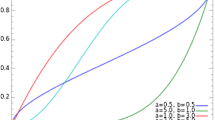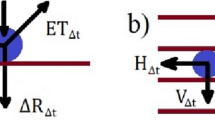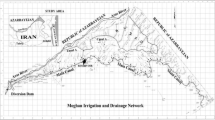Abstract
In this paper, an innovative framework is developed for simulating the water distribution in agricultural lands considering existing constraints related to soil, water, atmosphere and plant. Some nonlinear operating rules are formulated for the irrigation planning and groundwater management in Shahrekord plain in Iran. Evapotranspiration values are estimated based on a real-time modeling. Groundwater exploitations are limited for each irrigated area by considering its actual water requirement and soil moisture balance with daily time steps at the root zone. Moreover, this work introduces an approach for taking into account the uncertainty of available water. For this purpose, the membership functions of fuzzy inputs are discretized into five levels and then a multiobjective optimization model is developed to find the extreme values of economic efficiency of irrigation water for different levels. The results show that under limited water conditions, the economic productivity could be further improved when water, soil, atmosphere and crop relationships are simultaneously considered. In the proposed cropping pattern, the net annual return was increased by more than 43% comparing to the existing cropping pattern. Furthermore, different efficiency criteria for crops with higher values of yield production (e.g., potato, maize, sugar beet and alfalfa) are more affected by the existing uncertainties.




















Similar content being viewed by others
References
Abbasi N, Bahramloo R, Movahedan M (2015) Strategic planning for remediation and optimization of irrigation and drainage networks: a case study for Iran. Agric Agric Sci Procedia 4:211–221
Akbari M, Toomanian N, Droogers P, Bastiaanssen W, Gieske A (2007) Monitoring irrigation performance in Esfahan, Iran, using NOAA satellite imagery. Agri Water Manag 88:99–109
Alvarez JFO, Valero JAJ, Benito JMT, Mata EL (2004) MOPECO: an economic optimization model for irrigation water management. Irrigation Sci. 23:61–75
Deb K, Pratap A, Agarwal S, Meyarivan T (2002) A fast and elitist multi-objective genetic algorithm: NSGA-II. IEEE Trans Evol Commun 6:181–197
Fakharinia M, Lalehzari R, Yaghoobzadeh M (2012) The use of subsurface barriers in the sustainable management of groundwater resources. World Appl Sci J 19(11):1585–1590
Fallah-Mehdipour E, Bozorg Haddad O, Marino MA (2013) Extraction of multi-crop planning rules in a reservoir system: application of evolutionary algorithms. J Irrigation Drain Eng. https://doi.org/10.1061/(ASCE)IR.1943-4774.0000572
Grafton QR, Hussey K (2011) Water resources planning and management. Cambridge University Press, New York
Haghighi A, Zahedi-Asl A (2014) Uncertainty analysis of water supply networks using the fuzzy set theory and NSGA-II. Eng Appl Artif Int 32:270–282
Hsiao TC, Steduto P, Fereres E (2007) A systematic and quantitative approach to improve water use efficiency in agriculture. Irrigation Sci 25:209–231
Huang J, Ridoutt BG, Chang X, Zheng H, Chen F (2012) Cropping pattern modifications change water resource demands in the Beijing metropolitan area. J Integr Agric 11(11):1914–1923
Jakeman AJ, Barreteau O, Hunt BJ, Rinaudo JD, Ross N (2016) Integrated groundwater management. Springer, New York, p 756
Karamouz M, Kerachian R, Zahraie B (2004) Monthly water resources and irrigation planning: case study of conjunctive use of surface and groundwater resources. J Irrig Drain Eng 130(5):391–402
Karamouz M, Rezapour-Tabari MM, Kerachian R (2007) Application of genetic algorithm and artificial neural networks in conjunctive use of surface and groundwater resources. J Water Int 32(1):163–176
Karamouz M, Zahraie B, Kerachian R, Eslami A (2010) Crop pattern and conjunctive use management: a case study. Irrig Drain 59(2):161–173
Lalehzari R (2017) Closure to “Multi-objective management of water allocation to sustainable irrigation planning and optimal cropping pattern”. J Irrigation Drain Eng ASCE. https://doi.org/10.1061/(ASCE)IR.1943-4774.0001144
Lalehzari R, Boroomand-Nasab S (2017) Improved volume balance using upstream flow depth for advance time estimation. Agric Water Manag 186:120–126
Lalehzari R, Kerachian R (2020) Developing a framework for daily common pool groundwater allocation to demands in agricultural regions. Agric Water Manag 241:106278
Lalehzari R, Tabatabaei SH (2015) Simulating the impact of subsurface dam construction on the change of nitrate distribution. Environ Earth Sci 74:3241–3249
Lalehzari R, Tabatabaei SH, Kholghi M (2013) Simulation of nitrate transport and wastewater seepage in groundwater flow system. Int J Environ Sci Technol 10:1367–1376
Lalehzari R, Tabatabaei SH, Kholghi M, Yarali N, Saba AA (2014) Evaluation of Scenarios in artificial recharge with treated wastewater on the quantity and quality of Shahrekord aquifer. J Environ Stud 40(1):52–55
Lalehzari R, Ansari Samani F, Boroomand-Nasab S (2015) Analysis of evaluation indicators for furrow irrigation using opportunity time. Irrigation Drain 64(1):85–92
Lalehzari R, Boroomand-Nasab S, Moazed H, Haghighi A (2016) Multi-objective management of water allocation to sustainable irrigation planning and optimal cropping pattern. J Irrigation Drain Eng. https://doi.org/10.1061/(ASCE)IR.1943-4774.0000933
Li X, Zhang J, Liu J, Liu J, Zhu A, Lv F, Zhang C (2011) A modified checkbook irrigation method based on GIS-coupled model for regional irrigation scheduling. Irrigation Sci 29:115–126
Lorite IJ, Mateos L, Orgaz F, Fereres E (2007) Assessing deficit irrigation strategies at the level of an irrigation district. Agric Water Manag 91:51–60
Montazar A (2013) A decision tool for optimal irrigated crop planning and water resources sustainability. J Glob Optim 55:641–654
Nikoo MR, Kerachian R, Karimi A, Azadnia AA (2013) Optimal water and waste-load allocations in rivers using a fuzzy transformation technique: a case study. Environ Monit Assess 185(3):2483–2502
Noory H, Liaghat AM, Parsinejad M, Bozorg Haddad O (2012) Optimizing irrigation water allocation and multicrop planning using discrete PSO algorithm. J Irrigation Drain Eng ASCE 138(5):437–444
Parsinejad M, Bemani-Yazdi A, Araghinejad S, Nejadhashemi AP, Sarai Tabrizi M (2013) Optimal water allocation in irrigation networks based on real time climatic data. Agric Water Manag. 117:1–8
Shi Y, Eberhart R (1999) Empirical study of particle swarm optimization. In: Proceeding IEEE international congers evolutionary computation, Washington, DC, USA, pp 1945–1950
Singh A (2015) Land and water management planning for increasing farm income in irrigated dry areas. Land Use Pol 42:244–250
Singh A, Panda SN (2012) Development and application of an optimization model for the maximization of net agricultural return. Agric Water Manag 115:267–275
Soltani M, Kerachian R, Nikoo MR, Noory H (2016) A conditional value at risk-based model for planning agricultural water and return flow allocation in river systems. Water Resour Manage 30(1):427–443
Tabatabaei SH, Lalehzari R, Nourmahnad N, Khazaei M (2010) Groundwater quality and land use change (a case study: Shahrekord aquifer, Iran). J Res Agric Sci 6:39–48
Turner K, Georgiou S, Clark R, Brouwer R, Burke J (2004) Economic valuation of water resources in agriculture. FAO water reports, p 204
Varade S, Patel JN (2018) Determination of optimum cropping pattern using advanced optimization algorithms. J Hydrol Eng 23(6):05018010
Vedula S, Mujumdar PP, Sekhar GC (2005) Conjunctive use modeling for multicrop irrigation. Agric Water Manag 73:193–221
Veysi S, Naseri AA, Hamzeh S, Bartholomeus H (2017) A satellite based crop water stress index for irrigation scheduling in sugarcane fields. Agric Water Manag 189:70–86
Acknowledgements
This research has been supported by Iran National Science Foundation (INSF) under Grant Number 95000151.
Author information
Authors and Affiliations
Corresponding author
Rights and permissions
About this article
Cite this article
Lalehzari, R., Kerachian, R. An Integrated Framework for Optimal Irrigation Planning Under Uncertainty: Application of Soil, Water, Atmosphere and Plant Modeling. Iran J Sci Technol Trans Civ Eng 45, 429–442 (2021). https://doi.org/10.1007/s40996-020-00442-5
Received:
Accepted:
Published:
Issue Date:
DOI: https://doi.org/10.1007/s40996-020-00442-5




